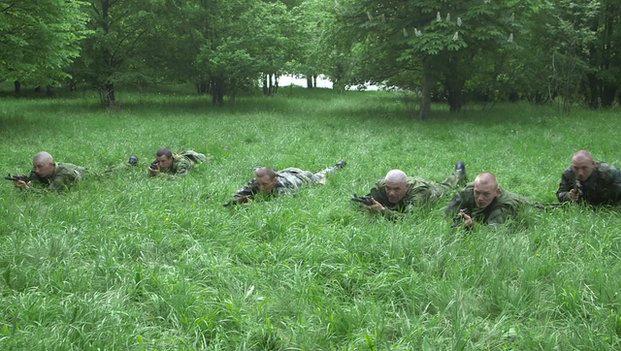Behind the Balaclavas – embedded with Ukraine’s separatist militias
The BBC was given access to this armed militia group near the Ukrainian border with Russia. The group’s leader, Alexei Mozgovoi, was evasive when asked where the weapons had come from.
In the last few months, Ukraine’s pro-Russian militias have become a familiar presence on our TV screens: anonymous, heavily armed, masked men occupying government buildings across the east of the country.
They aren’t particularly keen on western journalists, and asking them questions they don’t like can be a risky business.
One team from The World’s partners at the BBC did manage to get access, however.
Reporter Paul Kenyon spent weeks embedded with the separatists as they seized government buildings and fought for their own breakaway republic. His documentary, "Behind The Balaclavas" shows how quickly rule by militia has been normalized in eastern Ukraine.
“It’s surreal. You walk through these [occupied] buildings and you have basically got 10 floors of people wearing balaclavas, skeleton masks, all of them have got baseball bats, chair legs- they’ve all got weapons,” Kenyon says. “I’d think: ‘You all look pretty threatening.’ [But] my attitude was that some of these people have got to be reasonable. And they were."
Kenyon and his team spent time with Alexei, a man who used to work as a building contractor only a few months ago. Alexei now leads his own private army of more than a hundred heavily armed men, with their own training camp at a secret location near the Russian border. Kenyon asked Alexei where his men’s weapons came from, and got a deadpan answer.
‘‘Barack Obama. Barack Obama gave us weapons through his politics. If he stayed at home and ran his own country and not poked his nose into others, there wouldn’t be any weapons. Not in Syria, not in Libya and not here."
Ordinary life in the eastern Ukraine also continues alongside the political crisis. In occupied municipal buildings in Donetsk, local council meetings were being held next door to sniper positions and production lines for Molotov cocktails.
"If you didn’t know better and you were zapped there from outer space, you’d think it was in a local town hall anywhere in America or Europe," Kenyon says. “It’s only when you open the door and see men with machine guns and Molotov cocktails and skeleton masks that you realise it’s something different.”
As to whether there is a chance of the militias returning to civilian life, Kenyon is pessimistic.
"These people have gone so far that there is absolutely no turning back," he says. "When you get a man who used to run a building company who has now got own private army … with AK47s and machine guns – this is a man who is not for turning back."
According to Kenyon, Alexei and his militia are not unusual. "This is happening repeatedly through that area the region. The word on the ground is – these men will not give up until they are absorbed into the Russian federation."
In the last few months, Ukraine’s pro-Russian militias have become a familiar presence on our TV screens: anonymous, heavily armed, masked men occupying government buildings across the east of the country.
They aren’t particularly keen on western journalists, and asking them questions they don’t like can be a risky business.
One team from The World’s partners at the BBC did manage to get access, however.
Reporter Paul Kenyon spent weeks embedded with the separatists as they seized government buildings and fought for their own breakaway republic. His documentary, "Behind The Balaclavas" shows how quickly rule by militia has been normalized in eastern Ukraine.
“It’s surreal. You walk through these [occupied] buildings and you have basically got 10 floors of people wearing balaclavas, skeleton masks, all of them have got baseball bats, chair legs- they’ve all got weapons,” Kenyon says. “I’d think: ‘You all look pretty threatening.’ [But] my attitude was that some of these people have got to be reasonable. And they were."
Kenyon and his team spent time with Alexei, a man who used to work as a building contractor only a few months ago. Alexei now leads his own private army of more than a hundred heavily armed men, with their own training camp at a secret location near the Russian border. Kenyon asked Alexei where his men’s weapons came from, and got a deadpan answer.
‘‘Barack Obama. Barack Obama gave us weapons through his politics. If he stayed at home and ran his own country and not poked his nose into others, there wouldn’t be any weapons. Not in Syria, not in Libya and not here."
Ordinary life in the eastern Ukraine also continues alongside the political crisis. In occupied municipal buildings in Donetsk, local council meetings were being held next door to sniper positions and production lines for Molotov cocktails.
"If you didn’t know better and you were zapped there from outer space, you’d think it was in a local town hall anywhere in America or Europe," Kenyon says. “It’s only when you open the door and see men with machine guns and Molotov cocktails and skeleton masks that you realise it’s something different.”
As to whether there is a chance of the militias returning to civilian life, Kenyon is pessimistic.
"These people have gone so far that there is absolutely no turning back," he says. "When you get a man who used to run a building company who has now got own private army … with AK47s and machine guns – this is a man who is not for turning back."
According to Kenyon, Alexei and his militia are not unusual. "This is happening repeatedly through that area the region. The word on the ground is – these men will not give up until they are absorbed into the Russian federation."
